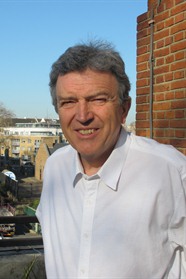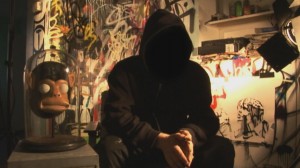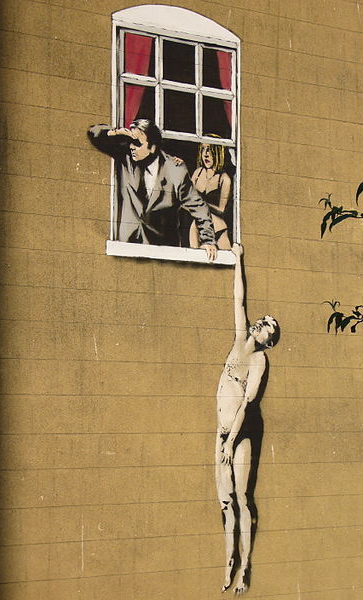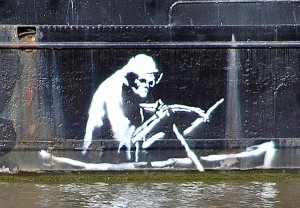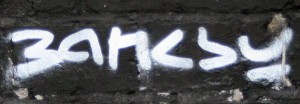“Banksy has almost single-handedly produced a new art world for a new audience, running alongside the existing world and now, slowly but surely, within it. And there is room for both.”
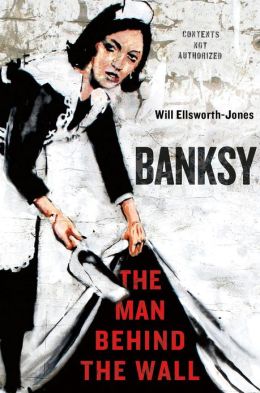 If Banksy is now considered part of the recognized art world, as author Will Ellsworth-Jones contends in this enlightening biography, it is certainly not what Banksy himself would ever have envisioned when he was growing up. Dedicated to preserving his personal anonymity, Banksy, according to an acquaintance, was born in 1974, in Bristol, England, then the center of a lively graffiti “art scene.” Featuring nightly battles between young men armed with aerosol paint cans and the police who wanted to arrest them for defacing property, this scene was a counterculture phenomenon centered around Barton Hill, a less “leafy” neighborhood than the one in which Banksy himself grew up. He joined that night-time scene, however, when he was only fourteen, escaping a police roundup of seventy-two older, better-known graffiti artists in the late 1980s.
If Banksy is now considered part of the recognized art world, as author Will Ellsworth-Jones contends in this enlightening biography, it is certainly not what Banksy himself would ever have envisioned when he was growing up. Dedicated to preserving his personal anonymity, Banksy, according to an acquaintance, was born in 1974, in Bristol, England, then the center of a lively graffiti “art scene.” Featuring nightly battles between young men armed with aerosol paint cans and the police who wanted to arrest them for defacing property, this scene was a counterculture phenomenon centered around Barton Hill, a less “leafy” neighborhood than the one in which Banksy himself grew up. He joined that night-time scene, however, when he was only fourteen, escaping a police roundup of seventy-two older, better-known graffiti artists in the late 1980s.
Excited by the hit-and-run atmosphere which surrounded these street artists, Banksy once admitted to an interviewer that “it was only when he had an aerosol spray can in his hand that he discovered his voice,” painting on walls where it was legal – and any place else where he could be unobserved. Often that meant painting over someone else’s work, an accepted practice among graffiti artists, since no one expected any of this work to last. As the author points out, “What surprised me in talking to graffiti writers…is the redemptive power that graffiti sometimes carries. The fact that on occasions it can bring hope and even a life to kids…who were going nowhere until they found the excitement and the skill in painting graffiti on the street.” For these artists, the work itself was the thrill, and Banksy never really regretted his work’s disappearance (sometimes in as little as two hours) and sometimes after a few days.
Graffiti is a “lawless activity with a million and one laws.” For most artists the “passion and fame…the comradeship, the challenge, and the fear” shared among other artists is what it is all about, but many “graffiti artists” do not consider Banksy one of them at all. One fellow artist, who recognizes Banksy as a genius, explains that graffiti artists “only write their name and do characters and it’s a whole ego trip and it’s all about us and our peers. It’s not about the public.” For Banksy, however, it is all about the public and the wider audience he seeks. “[He is] painting the same walls as a graffiti artist but [he is] producing images which are instantly understandable – a gallery on the street that is inclusive rather than exclusive. The image can be pure humour or social commentary or both, but every passer-by gets the joke.”
In finding his style, Banksy abandoned the characters and the “bomb and run” style of his early freehand painting in favor of working as a stencil artist, which requires precision, advance planning, and organization. For those stenciled images which have several colors, several stencils are needed. These must be rolled up and carried easily, then unrolled, attached to a wall, and spray-painted. After the stencil is attached to the wall, the painting itself takes only seconds – and the stencils can be reused. The designs, especially those with a social message, can then be repeated in more than one area. Freehand artists in Bristol hated these new images, but the public loved them for their accessible style, dark humor, and contemporary messages, often anti-war, anti-poverty, and always anti-establishment.
Eventually, Banksy left Bristol for London. A terrible feud between Banksy and Robbo, another artist, led to nearly all of Banksy’s work in Bristol being destroyed or painted over by Robbo or his posse, some work gone before he left and nearly all that remained destroyed after his departure. In addition, the anonymity he so insisted on had been threatened – too many people knew him – and he did not have as much freedom to move around as he wanted. In London he continued his work, and fame pursued him. Much of that work, too, has now been physically removed – sold at auctions, through galleries, or privately, for large sums. A tour book leading a viewer to “all the sites of Banksy’s work in London,” purchased by the author, shows that of the original fifty-two art pieces featured, only seven survive.
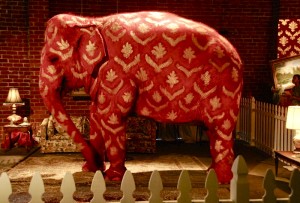
"The Elephant in the Room," representing the issue of people who live in poverty without clean water, from the Los Angeles show
Banksy’s reputation really blossomed beginning in 2003, with his “Art of Infiltration,” in which he scoped out museums, then entered quietly, went to a pre-planned site, and posted his own work on the walls. In 2003, it was the Tate Modern, followed by seven more galleries in the next seventeen months. He infiltrated the Natural History Museum and the Louvre, posting his work. In 2005, he “infiltrated” four museums in New York City, without being stopped once, filming each of his installations. These breaches of security brought him fame and recognition and the fun of seeing his work in newspapers, on television, and on the internet. He had a show in Los Angeles, and other shows continued. In 2008, Banksy was given an exhibition at the Bristol City Museum and Art Gallery. He also sold 135,000 copies of his book, Wall and Piece, and auction sales for his work were also brisk. At a Sotheby’s auction to raise money for AIDS programs in Africa, for example, his prices ranged from $385,000 to $960,000, with the painting on the cover of this book, “Keep It Spotless,” selling for $1.8 million at that auction.
Author Ellsworth-Jones provides many anecdotes and stories about Banksy, his art, his antics, and his loyal coterie, Pest Control, giving attention to a form of art that is less guerrilla style than it once was, emphasizing Banksy’s continuing desire to remain anonymous. His information about the people with whom Banksy has worked and his many projects, including his film, “Exit Through the Gift Shop,” (See video after the photo credits here.) will keep readers both entertained and interested in the Banksy phenomenon and in street art itself. The chronology of the book jumps around without enough references to dates, making a time sequence a bit difficult to ascertain, and there is no discussion about what constitutes real “art,” but the book provides an in-depth look at a little known, counterculture phenomenon, and I, at least, will never be able to look at the graffiti-covered concrete walls of the buildings I pass on the train to the city without wondering if another Banksy is being birthed in my own corner of the world.
ARC: St. Martin’s Press
Photos, in order: The author’s photo appears on http://us.macmillan.com/
The “image” of Banksy, accompanies a story by David Edelstein about the Banksy film, “Exit Through the Gift Shop,” which appears on http://www.npr.org/
“The Lovers,” photographed by Richard Cocks, appears on http://commons.wikimedia.org
This Bansky work, painted on the side of the Thekla Social entertainment boat, central Bristol, was photographed by Adrian Pingstone and appears on http://commons.wikimedia.org
“The Elephant in the Room,” photographed by Bit Boy appears on http://commons.wikimedia.org It represents the issue of poverty-stricken people who do not have clean water, and was part of the show in Los Angeles, 2006.
Banksy’s “tag” is from http://www.banksy-wallpaper.com
An excerpt from the Banksy film, “Exit Through the Gift Shop,” produced by Paranoid Pictures, and posted on YouTube by “banksyfilm”:
